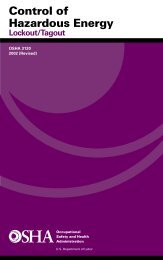Toxic Chemical Release Inventory Reporting Forms and Instructions
Toxic Chemical Release Inventory Reporting Forms and Instructions
Toxic Chemical Release Inventory Reporting Forms and Instructions
Create successful ePaper yourself
Turn your PDF publications into a flip-book with our unique Google optimized e-Paper software.
Important Information for <strong>Reporting</strong> Year 2003<br />
’ The TRI-ME RY 2003 “Load Data” functionality has been updated. TRI-ME RY 2003 allows you to save time by<br />
loading data from files created by TRI-ME or third-party software. You may load current (RY 2003) data created by TRI-<br />
ME or third-party software, or you may load data from RY 2002 to assist you in completing this year’s forms.<br />
’ The Form R has been changed for <strong>Reporting</strong> Year 2003. TRI-ME RY 2003 has been modified to support these changes.<br />
’ Use of the ATRS was discontinued after <strong>Reporting</strong> Year 2001. ATRS 2001, however, may still be used to revise data for<br />
reporting years 1987 to 2001.<br />
The following information consists of updates to the <strong>Reporting</strong> <strong>Forms</strong> <strong>and</strong> <strong>Instructions</strong> from previous reporting years.<br />
’ Starting with reporting year 2002, facilities can determine their latitude <strong>and</strong> longitude by using the TRI Facility Siting<br />
Tool found on the TRI Home page. For more information about the siting tool see Appendix E.<br />
’ Starting with reporting year 2001, lead <strong>and</strong> lead compounds are classified as persistent, bioaccumulative <strong>and</strong> toxic (PBT)<br />
chemicals. The reporting thresholds for lead <strong>and</strong> lead compounds, except when lead is contained in stainless steel, brass<br />
or bronze alloys, have been lowered to 100 pounds. For specific guidance on the reporting of lead, see page 15.<br />
’ Starting with reporting year 2001 the qualifier for isopropyl alcohol has been changed to match exactly the qualifier that<br />
is listed in the Code of Federal Regulations, the new qualifier is “Only persons who manufacture by the strong acid<br />
process are subject, no supplier notification.” EPA believes that use of this qualifier will make it clearer that only<br />
facilities that manufacture isopropyl alcohol by the strong acid process are subject to reporting (i.e., processors <strong>and</strong> users<br />
of isopropyl alcohol are not subject to reporting).<br />
” A list of EPCRA section 313 industry-specific <strong>and</strong> chemical-specific guidance documents <strong>and</strong> information on ordering<br />
these documents free of charge is provided on page vii.<br />
’ Starting with reporting year 2000, new chemical activity threshold levels are set for persistent, bioaccumulative <strong>and</strong> toxic<br />
(PBT) chemicals <strong>and</strong> chemical categories (Section B.4.e).<br />
<strong>Toxic</strong>s <strong>Release</strong> <strong>Inventory</strong> <strong>Reporting</strong> <strong>Forms</strong> <strong>and</strong> <strong>Instructions</strong> for RY2003
















